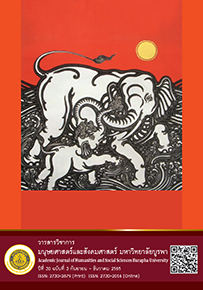Communicating the Meanings of Local Thai Cuisines in Nonglom Sub-district, Dok Kham Tai District, Phayao Province
Main Article Content
Abstract
This qualitative research aimed at studying the communication and construction of meanings behind local Thai cuisines in the Nonglom community, Dok Kham Tai District, Phayao Province. The research instrument for data collection included a focus group discussion, participant observation, and group interview. The concept of multidimensional knowledge about food and the semiotic theory were employed as the frameworks for data analyses.
The research findings showed that local Thai cuisines from the Nonglom community, Dok Kham Tai District, Phayao Province, represented seven dimensions of knowledge about food, of which agricultural and local wisdom dimensions were found the most dominant. The other five dimensions, which were communicated to the same extent, included cooking tips, ways of life, culture, language and history. Also, the “set of signs representing local Thai cuisines” included 1) the meaning of the sign of authentic local Thai cuisines. This consists of index signs, such as rice, rice flour, vegetables and fruits, cooking ingredients and meat, and the cooking process, such as using heat from water vapor, frying, deep frying, stir frying, flaming, as well as other unique Thai cooking methods. The other set of signs was 2) the meaning of the signs of expertise, with the index signs that were conserved and re-created. Finally, the research result found four menus showing signs of conservation and three representing the re-creation of local Thai cuisines.
Downloads
Article Details

This work is licensed under a Creative Commons Attribution-NonCommercial-NoDerivatives 4.0 International License.
บทความทุกบทความเป็นลิขสิทธิ์ของวารสารวิชาการมนุษยศาสตร์และสังคมศาสตร์ มหาวิทยาลัยบูรพาเท่านั้น
References
กาญจนา แก้วเทพ. (2553). แนวพินิจใหม่ในสื่อสารศึกษา. ภาพพิมพ์.
เกศณีย์ สัตตรัตนขจร, สนธิยา สุวรรณราช และกาญจนา คุมา. (2563). การพัฒนาอาหารพื้นถิ่นแบบมีส่วนร่วมเพื่อหนุนเสริมการท่องเที่ยวสร้างสรรค์เชิงวัฒนธรรมของจังหวัดลำปาง. https://so04.tcithaijo.org/index.php/jnuks/article/ download/225755/164621/835713
ขจิตขวัญ กิจวิสาละ. (2559). การสื่อสารความหมายของอาหารไทยในร้านอาหารไทยชั้นนำ. วารสารศาสตร์, 9(3), 45-115.
ชณิตา ประดิษฐ์สถาพร, เอกอุรินทร์ ดวงทิพย์, ณิฌารี อิติอินทร์, มนฑน์กาญจน์ ปิ่นภู่ และวิไลพร วงศ์คินี. (2560). ตำรับอาหารพื้นบ้านพะเยา: การสืบสานภูมิปัญญาท้องถิ่นและคุณค่าทางโภชนาการ. วารสารวิจัยเพื่อการพัฒนาเชิงพื้นที่, 9(4), 297-313.
เทศบาลตำบลหนองหล่ม. (ม.ป.ป.). ประวัติตำบลหนองหล่ม. https://www.nonglomphayao.go.th/ index/?page=newarticle17803296
ประกอบศิริ ภักดีพินิจ และปานณนาถ ศักดิ์ศิริคุณ. (2565). ศักยภาพทางการท่องเที่ยวเชิงเกษตรโดยชุมชนในพื้นที่กลุ่มจังหวัดล้านนาตะวันออก. วารสารมนุษยศาสตร์และสังคมศาสตร์ มหาวิทยาลัยพะเยา, 10(1), 261-279.
ปวิธ ตันสกุล. (2563). แนวทางการส่งเสริมอาหารพื้นถิ่นเพื่อการท่องเที่ยวเชิงอาหารกรณีศึกษาชุมชนขนาบนาก อำเภอปากพนัง จังหวัดนครศรีธรรมราช. WMS Journal of Management, 9(1), 81-92.
อภิญญาภรณ์ โสภา. (2564). การวางแผนนวัตกรรมการตลาดท่องเที่ยวเชิงอาหารพื้นถิ่น. ใน การประชุมงานวิจัยด้านการจัดการบริหารธุรกิจครั้งที่ 13 (หน้า 34-44). คณะบริหารธุรกิจ มหาวิทยาลัยเชียงใหม่.
อริสา สาขากร. (2561). การสื่อความหมายและการสร้างอัตลักษณ์ร้านคาเฟ่ขนมไทยในเขตกรุงเทพมหานคร. [วิทยานิพนธ์ศิลปศาสตรมหาบัณฑิต, มหาวิทยาลัยธรรมศาสตร์].
เอื้องอริณ สายจันทร์. (2561). บทบาทของรายการอาหารทางโทรทัศน์ในการถ่ายทอดความรู้เกี่ยวกับอาหารเพื่อสืบทอดวัฒนธรรมอาหาร. ใน กาญจนา แก้วเทพ (บรรณาธิการ), “เรื่องกินเรื่องใหญ่” วัฒนธรรมแห่งอาหารกับชุมชนศึกษา (หน้า 27-33). ภาพพิมพ์.
Najpinij, N. (2011). Constructing “Thainess” within international food space: Thai gastronomy in five-star hotels in Bangkok. [Doctoral dissertation of Thai Studies, Chulalongkorn University].
The Cloud. (2020, December 24). เทคนิคการทำอาหารแบบ Slow Cooking|ออกรส|Ep.36: หุง อุ่น ตุ๋น ต้ม นึ่ง. [Video]. https://www.youtube.com/watch?v= OP0oFFkuOqY


